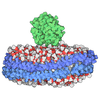[English] 日本語
 Yorodumi
Yorodumi- PDB-2dko: Extended substrate recognition in caspase-3 revealed by high reso... -
+ Open data
Open data
- Basic information
Basic information
| Entry | Database: PDB / ID: 2dko | ||||||
|---|---|---|---|---|---|---|---|
| Title | Extended substrate recognition in caspase-3 revealed by high resolution X-ray structure analysis | ||||||
 Components Components |
| ||||||
 Keywords Keywords | HYDROLASE/HYDROLASE INHIBITOR / LOW BARRIER HYDROGEN BOND / CASPASE / DRUG DESIGN / RADIATION DAMAGE / TETRAHEDRAL INTERMEDIATE / PROTEASE / HYDROLASE-HYDROLASE INHIBITOR COMPLEX | ||||||
| Function / homology |  Function and homology information Function and homology informationcaspase-3 / Stimulation of the cell death response by PAK-2p34 / phospholipase A2 activator activity / anterior neural tube closure / intrinsic apoptotic signaling pathway in response to osmotic stress / leukocyte apoptotic process / positive regulation of pyroptotic inflammatory response / glial cell apoptotic process / NADE modulates death signalling / luteolysis ...caspase-3 / Stimulation of the cell death response by PAK-2p34 / phospholipase A2 activator activity / anterior neural tube closure / intrinsic apoptotic signaling pathway in response to osmotic stress / leukocyte apoptotic process / positive regulation of pyroptotic inflammatory response / glial cell apoptotic process / NADE modulates death signalling / luteolysis / response to cobalt ion / cellular response to staurosporine / death-inducing signaling complex / cyclin-dependent protein serine/threonine kinase inhibitor activity / response to anesthetic / Apoptosis induced DNA fragmentation / Apoptotic cleavage of cell adhesion proteins / Caspase activation via Dependence Receptors in the absence of ligand / SMAC, XIAP-regulated apoptotic response / Activation of caspases through apoptosome-mediated cleavage / death receptor binding / Signaling by Hippo / SMAC (DIABLO) binds to IAPs / SMAC(DIABLO)-mediated dissociation of IAP:caspase complexes / axonal fasciculation / regulation of synaptic vesicle cycle / fibroblast apoptotic process / epithelial cell apoptotic process / Other interleukin signaling / platelet formation / negative regulation of cytokine production / positive regulation of amyloid-beta formation / execution phase of apoptosis / negative regulation of B cell proliferation / Apoptotic cleavage of cellular proteins / pyroptotic inflammatory response / negative regulation of activated T cell proliferation / T cell homeostasis / neurotrophin TRK receptor signaling pathway / B cell homeostasis / negative regulation of cell cycle / response to tumor necrosis factor / cell fate commitment / response to amino acid / response to X-ray / Pyroptosis / regulation of macroautophagy / Caspase-mediated cleavage of cytoskeletal proteins / response to glucose / response to glucocorticoid / response to UV / keratinocyte differentiation / striated muscle cell differentiation / Degradation of the extracellular matrix / intrinsic apoptotic signaling pathway / protein maturation / enzyme activator activity / erythrocyte differentiation / hippocampus development / response to nicotine / apoptotic signaling pathway / sensory perception of sound / protein catabolic process / regulation of protein stability / protein processing / response to hydrogen peroxide / response to wounding / neuron differentiation / positive regulation of neuron apoptotic process / response to estradiol / peptidase activity / heart development / protease binding / neuron apoptotic process / response to lipopolysaccharide / aspartic-type endopeptidase activity / learning or memory / response to hypoxia / postsynaptic density / response to xenobiotic stimulus / cysteine-type endopeptidase activity / neuronal cell body / apoptotic process / DNA damage response / protein-containing complex binding / glutamatergic synapse / proteolysis / nucleoplasm / nucleus / cytosol / cytoplasm Similarity search - Function | ||||||
| Biological species |  Homo sapiens (human) Homo sapiens (human) | ||||||
| Method |  X-RAY DIFFRACTION / X-RAY DIFFRACTION /  SYNCHROTRON / SYNCHROTRON /  MOLECULAR REPLACEMENT / Resolution: 1.06 Å MOLECULAR REPLACEMENT / Resolution: 1.06 Å | ||||||
 Authors Authors | Mittl, P.R.E. / Ganesan, R. / Jelakovic, S. / Grutter, M.G. | ||||||
 Citation Citation |  Journal: J.Mol.Biol. / Year: 2006 Journal: J.Mol.Biol. / Year: 2006Title: Extended Substrate Recognition in Caspase-3 Revealed by High Resolution X-ray Structure Analysis Authors: Ganesan, R. / Mittl, P.R.E. / Jelakovic, S. / Grutter, M.G. | ||||||
| History |
|
- Structure visualization
Structure visualization
| Structure viewer | Molecule:  Molmil Molmil Jmol/JSmol Jmol/JSmol |
|---|
- Downloads & links
Downloads & links
- Download
Download
| PDBx/mmCIF format |  2dko.cif.gz 2dko.cif.gz | 123.8 KB | Display |  PDBx/mmCIF format PDBx/mmCIF format |
|---|---|---|---|---|
| PDB format |  pdb2dko.ent.gz pdb2dko.ent.gz | 95.8 KB | Display |  PDB format PDB format |
| PDBx/mmJSON format |  2dko.json.gz 2dko.json.gz | Tree view |  PDBx/mmJSON format PDBx/mmJSON format | |
| Others |  Other downloads Other downloads |
-Validation report
| Arichive directory |  https://data.pdbj.org/pub/pdb/validation_reports/dk/2dko https://data.pdbj.org/pub/pdb/validation_reports/dk/2dko ftp://data.pdbj.org/pub/pdb/validation_reports/dk/2dko ftp://data.pdbj.org/pub/pdb/validation_reports/dk/2dko | HTTPS FTP |
|---|
-Related structure data
| Related structure data |  2cjxC  2cjyC  1cp3S S: Starting model for refinement C: citing same article ( |
|---|---|
| Similar structure data |
- Links
Links
- Assembly
Assembly
| Deposited unit | 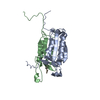
| ||||||||
|---|---|---|---|---|---|---|---|---|---|
| 1 | 
| ||||||||
| Unit cell |
| ||||||||
| Components on special symmetry positions |
|
- Components
Components
| #1: Protein | Mass: 16524.814 Da / Num. of mol.: 1 / Fragment: Caspase-3 p17 subunit, residues 29-174 Source method: isolated from a genetically manipulated source Source: (gene. exp.)  Homo sapiens (human) / Plasmid: pET11d / Production host: Homo sapiens (human) / Plasmid: pET11d / Production host:  References: UniProt: P42574, Hydrolases; Acting on peptide bonds (peptidases); Cysteine endopeptidases |
|---|---|
| #2: Protein | Mass: 11981.682 Da / Num. of mol.: 1 / Fragment: Caspase-3 p12 subunit, residues 175-277 / Mutation: D175A Source method: isolated from a genetically manipulated source Source: (gene. exp.)  Homo sapiens (human) / Plasmid: pET11d / Production host: Homo sapiens (human) / Plasmid: pET11d / Production host:  References: UniProt: P42574, Hydrolases; Acting on peptide bonds (peptidases); Cysteine endopeptidases |
| #3: Protein/peptide | |
| #4: Water | ChemComp-HOH / |
| Compound details | THE UNBOUND INHIBITOR (CHAIN I) IS CARBOBENZOXY-ASP-GLU-VAL-ASP-CHLOROMETHYLKETONE. UPON REACTION ...THE UNBOUND INHIBITOR (CHAIN I) IS CARBOBENZO |
| Has protein modification | Y |
-Experimental details
-Experiment
| Experiment | Method:  X-RAY DIFFRACTION / Number of used crystals: 1 X-RAY DIFFRACTION / Number of used crystals: 1 |
|---|
- Sample preparation
Sample preparation
| Crystal | Density Matthews: 2.35 Å3/Da / Density % sol: 47.73 % |
|---|---|
| Crystal grow | Temperature: 293 K / Method: vapor diffusion / pH: 4.75 / Details: pH 4.75, VAPOR DIFFUSION, temperature 293K |
-Data collection
| Diffraction | Mean temperature: 100 K |
|---|---|
| Diffraction source | Source:  SYNCHROTRON / Site: SYNCHROTRON / Site:  SLS SLS  / Beamline: X06SA / Wavelength: 0.8498 / Wavelength: 0.8498 Å / Beamline: X06SA / Wavelength: 0.8498 / Wavelength: 0.8498 Å |
| Detector | Type: MARRESEARCH / Detector: CCD / Date: May 29, 2005 |
| Radiation | Protocol: SINGLE WAVELENGTH / Monochromatic (M) / Laue (L): M / Scattering type: x-ray |
| Radiation wavelength | Wavelength: 0.8498 Å / Relative weight: 1 |
| Reflection | Resolution: 1.06→20 Å / Num. all: 113110 / Num. obs: 113110 / % possible obs: 92 % / Observed criterion σ(F): 0 / Observed criterion σ(I): 0 / Redundancy: 3.1 % / Rmerge(I) obs: 0.055 / Net I/σ(I): 7.9 |
| Reflection shell | Resolution: 1.06→1.15 Å / Rmerge(I) obs: 0.366 / Mean I/σ(I) obs: 3.06 / % possible all: 89 |
- Processing
Processing
| Software |
| |||||||||||||||||||||||||||||||||
|---|---|---|---|---|---|---|---|---|---|---|---|---|---|---|---|---|---|---|---|---|---|---|---|---|---|---|---|---|---|---|---|---|---|---|
| Refinement | Method to determine structure:  MOLECULAR REPLACEMENT MOLECULAR REPLACEMENTStarting model: 1cp3 Resolution: 1.06→20 Å / Num. parameters: 20202 / Num. restraintsaints: 24660 / Cross valid method: FREE R / σ(F): 0 / Stereochemistry target values: ENGH & HUBER
| |||||||||||||||||||||||||||||||||
| Refine analyze | Num. disordered residues: 20 / Occupancy sum hydrogen: 1933 / Occupancy sum non hydrogen: 2362.5 | |||||||||||||||||||||||||||||||||
| Refinement step | Cycle: LAST / Resolution: 1.06→20 Å
| |||||||||||||||||||||||||||||||||
| Refine LS restraints |
|
 Movie
Movie Controller
Controller




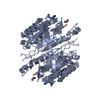

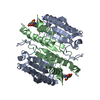

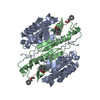

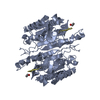

 PDBj
PDBj














